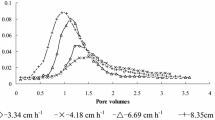Abstract
Contaminant transport to groundwater systems through the unsaturated zone follows, in most cases, preferential pathways. The understanding and assessment of this preferential flow mechanism is important to the prevention and solution of resulting problems. A column study was carried out where a NaCl-tracer solution (33 to 37 mmohs/cm of conductivity) was passed through an intact soil core under saturated conditions and three different ponding heights ranging from 5 to 30 mm. Outflow rates varied from 13 to 103 ml/min during the three tests performed. A subsequent dye tracing and slicing of the soil column was performed. Electrical conductivity measurements assessed indirectly the chloride content of the water outflow. Breakthrough curves (BTCs) showed short threshold times (less than 20% pore volume time) and asymmetry with respect to the point defined by C/Co = 0.5 and pore volume time. The BTCs successfully represent the flow measurements through the soil column, this fact is supported by the subsequent horizontal slicing (5 cm thick) of the intact core.
Similar content being viewed by others
References
J. L. Anderson and J. Bouma, “Water Movement through Pedal Soils: I Saturated Flow,” Soil Sci. Soc. Am. 41 413–418(1977).
C. Andre, M. Sardin, P. Vitorge, and M. H. Faure, “Analysis of Breakthrough Curves of Np V in Clayey and Packed Column in Terms of Mass Transfer Kinetics,” J. Cont. Hydrol. 35, 161–173 (1998).
M. S. Andreini and T. S. Steenhuis, “Preferential Paths of Flow under Conventional and Conservation Tillage,” Geoderma 46, 85–102 (1990).
M. S. Ashraf, B. Izadi, and B. King, “Transport of Bromide under Intermittent and Continuous Ponding Conditions,” J. Environ. Qual. 26, 69–75 (1997).
L. Bejat, E. Perfect, V. L. Quisenberry, et al., “Solute Transport as Related to Soil Structure in Unsaturated Intact Soil Blocks,” Soil Sci. Soc. Am. J. 64, 818–826 (2000).
K. Beven and P. Germann, “Macropores and Water Flow in Soils,” Water Resour. Rev. 18, 1311–1325 (1982).
V. Comegna, A. Coppola, A. Sommella, “Effectiveness of Equilibrium and Physical Nonequilibrium Approaches for Interpreting Solute Transport through Undisturbed Soil Columns,” J. Cont. Hydrol. 50, 121–138 (2001)
G. De Marsily, Quantitative Hydrogeology (Academic Press, Orlando, 1986), 440 pp.
J. Feyen, D. Jacques, A. Timmerman, J. Vanderborght, “Modeling Water Flow and Solute Transport in heterogeneous Soils: A Review of Recent Approaches,” J. Agric. Engng. Res. 70, 231–256 (1998).
M. Flury, J. Leuenberger, B. Studer, and H. Fluhler, “Transport of Anions and Herbicides in a Loamy and Sandy Field Soil,” Water Resour. Res. 31, 823–835 (1995).
F. Garrido, M. Ghodrati, M. Chendorain, and C. G. Campbell, “Small-Scale Variability in Solute Transport Processes in a Homogeneous Clay Loam Soil,” Soil Sci. Soc. Am. J. 63, 1513–1522 (1999).
P. Grindrod, M. S. Edwards, J. J. W. Higgo, and G. M. Williams, “Analysis of Colloid and Tracer Breakthrough Curves,” J. Cont. Hydrol. 21, 243–253 (1996).
D. E. Hill and Y. J. Parlange, “Wetting Front Instability in Layered Soils,” Soil Sci. Soc. Am. J. 63, 697–702 (1972).
S. K. Kamra, B. Lennartz, M. Th. van Genuchten, and P. Widmoser, “Evaluating Non-Equilibrium Solute Transport in Small Soil Columns,” J. Cont. Hydrol. 48, 189–212 (2001).
K. J. S. Kung, “Preferential Flow in a Sandy Vadose Zone: I. Field Observation,” Geoderma 46, 51–58 (1990).
K. J. S. Kung, E. J. Kladivko, T. J. Gish, et al., “Quantifying Preferential Flow by Breakthrough of Sequentially Applied Tracers: Silt Loam Soil,” Soil Sci. Soc. Am. J. 64, 1296–1304 (2000).
Y. Li and M. Ghodrati, “Preferential Transport of Nitrate through Soil Columns Containing Root Channels,” Soil Sci. Soc. Am. J. 58, 653–659 (1994).
Y. Li and M. Ghodrati, “Transport of Nitrate in Soils as Affected by Earthworm Activities,” J. Environ. Qual. 24, 432–438 (1995).
L. Ma and H. M. Selim, “Solute Transport in Soils under Conditions of Variable Flow Velocities,” Water Resour. Rev. 32, 3277–3283 (1996).
V. L. Quisenberry, R. E. Phillips, and J. M. Zeleznik, “Spatial Distribution of Water and Chloride Macropore Flow in a Well-Saturated Soil,” 58, 1294–1300 (1994).
H. S. Öztürk and I. Özkan, “Solute Movement in Large Soil Columns during Different Ponded Infiltration,” Aust. J. Agri. Res. 53, 183–189 (2002).
G. L. Ren, B. Izadi, B. King, and E. Dowding, “Preferential Transport in Unsaturated Cores under Different Irrigation Methods,” Soil Sci. 161, 214–225 (1996).
M. S. Seyfried and P. S. C. Rao, “Solute Transport in Undisturbed Columns of an Aggregated Tropical Soil: Preferential Flow Effects,” Soil Sci. Soc. Am. J. 51, 1434–1444 (1987).
J. Simunek, N. J. Jarvis, M. Th. van Genuchten, and A. Gardenas, “Review and Comparison of Models for Describing Non-Equilibrium and Preferential Flow and Transport in the Vadose Zone,” J. Hydrol. 272, 14–35 (2003).
J. Vanderborght, C. Gonzales, M. Vanclooster, et al., “Effects of Soil Type and Water Flux on Solute Transport,” Soil Sci. Soc. Am. J. 61, 372–389 (1997).
J. Vanderborght and H. Vereecken, “Analyses of Locally Measured Bromide Breakthrough Curves from a Natural Gradient Tracer Experiment at Krauthausen,” J. Cont. Hydrol. 48, 23–43 (2001).
J. Vanderborght and H. Vereecken, “Estimation of Local Scale Dispersion from Local Breakthrough Curves during a Tracer Test in a Heterogeneous Aquifer: the Lagrangian Approach,” J. Cont. Hydrol. 54, 141–171 (2002).
H. Vereecken, U. Jaekel, and H. Schwarze, “Analysis of Long-Term Behavior of Solute Transport with Nonlinear Equilibrium Sorption Using Breakthrough Curves and Temporal Moments,” J. Cont. Hydrol. 56, 271–294 (2002).
D. Wildenschild, K. H. Jensen, K. Villholth, and T. H. Illangasekare, “A Laboratory Analysis of the Effect of Macropores on Solute Transport,” Groundwater 32, 381–389 (1994).
Author information
Authors and Affiliations
Corresponding author
Additional information
The article is published in the original.
Rights and permissions
About this article
Cite this article
Tonguç, F., Merdun, H. Solute movement in an intact soil core under different ponding heights. Eurasian Soil Sc. 42, 1497–1503 (2009). https://doi.org/10.1134/S1064229309130109
Received:
Published:
Issue Date:
DOI: https://doi.org/10.1134/S1064229309130109




